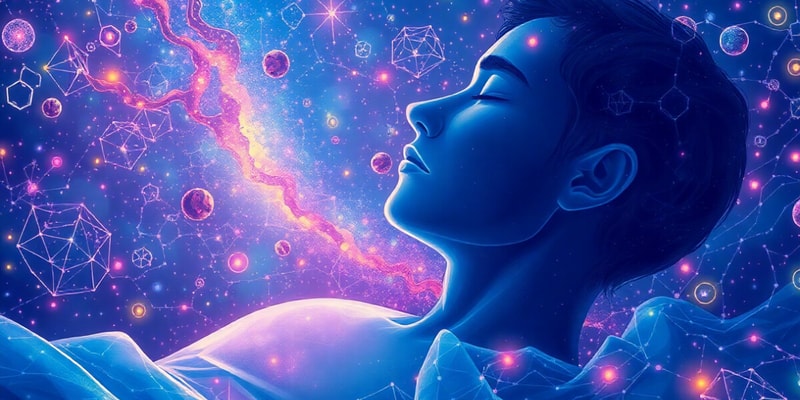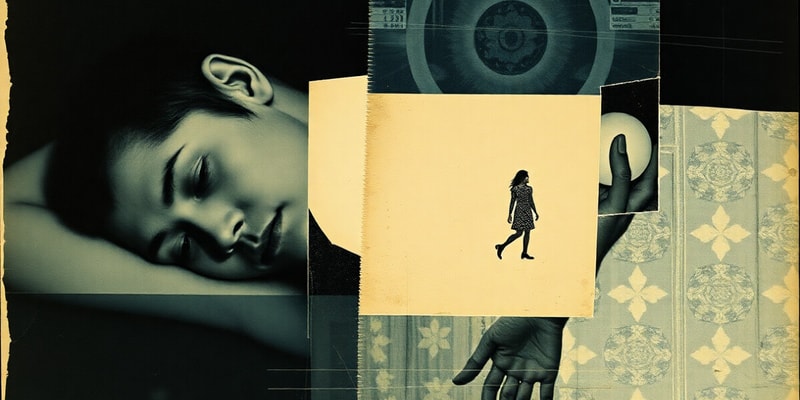Podcast
Questions and Answers
What defines Process C in the two process model of sleep?
What defines Process C in the two process model of sleep?
What unique characteristic is observed in avian NREM sleep in certain species?
What unique characteristic is observed in avian NREM sleep in certain species?
How does sleep typically change from childhood into old age?
How does sleep typically change from childhood into old age?
What finding did Barrett Klein's research reveal about sleep in bees?
What finding did Barrett Klein's research reveal about sleep in bees?
Signup and view all the answers
What is the stable ratio of NREM to REM sleep in adults?
What is the stable ratio of NREM to REM sleep in adults?
Signup and view all the answers
What physiological signal is primarily measured in polysomnography (PSG) to assess sleep stages?
What physiological signal is primarily measured in polysomnography (PSG) to assess sleep stages?
Signup and view all the answers
Which stage of sleep is characterized by the presence of K-complexes and sleep spindles?
Which stage of sleep is characterized by the presence of K-complexes and sleep spindles?
Signup and view all the answers
Which of the following neurotransmitters is at its highest level during REM sleep?
Which of the following neurotransmitters is at its highest level during REM sleep?
Signup and view all the answers
What does the term 'zeitgeber' refer to in the context of circadian rhythms?
What does the term 'zeitgeber' refer to in the context of circadian rhythms?
Signup and view all the answers
During which state are the primary neuromodulators regulating sleep/wake most imbalanced?
During which state are the primary neuromodulators regulating sleep/wake most imbalanced?
Signup and view all the answers
What aspect of circadian rhythms makes them considered 'endogenous'?
What aspect of circadian rhythms makes them considered 'endogenous'?
Signup and view all the answers
Which state of sleep is characterized by low muscle tone, absence of eye movements, and fast EEG activity?
Which state of sleep is characterized by low muscle tone, absence of eye movements, and fast EEG activity?
Signup and view all the answers
What is jet-lag, and what is a consequence of it?
What is jet-lag, and what is a consequence of it?
Signup and view all the answers
Study Notes
Polysomnography (PSG)
- PSG is a method of measuring sleep
- It uses three main signals: EEG, EOG, EMG
- EEG measures brain electrical activity
- EOG measures eye movements
- EMG measures muscle activity
Sleep Stages and Patterns
- NREM 3 & 4 are considered 'slow wave sleep'
- REM sleep involves no muscle tone, eye movements, and desynchronized brain waves
- NREM Stage 2 includes K-complexes and sleep spindles
- NREM-REM cycle in humans is ~90 minutes long
Neurochemicals and Sleep/Wake Regulation
- Wakefulness is associated with high frequency, low amplitude brainwaves
- During wakefulness, 3 primary neuromodulators are in equilibrium
- Neuromodulators are: Acetylcholine (ACh), norepinephrine (NE), and serotonin (5HT)
- NREM: Acetylcholine is decreased, as are NE and 5HT
- REM: NE and 5HT are at the lowest levels, while ACh is highest
- Brainstem, thalamus, and cortex are involved in regulating sleep/wake states
- The lateral prefrontal cortex is inactive during REM sleep
- PGO waves are associated with rapid eye movements and scene changes in dreams
Circadian Rhythms and Sleep
- Circadian rhythms are "endogenous"
- They persist without external cues, seen in the Mammoth Cave study
- Melatonin is released in response to darkness and helps regulate sleep onset
- Zeitgebers are external cues that reset the circadian clock
- Examples of zeitgebers: Light, activity, food, temperature, social cues
- Jet lag is a mismatch between biological clock and day/night cycle
- This can cause disorganized and misaligned circadian rhythms
- Two-process model of sleep:
- Process C: the circadian process that regulates biological rhythms
- Process S: sleep homeostasis regulated by sleep pressure
Animal Sleep
- All animals sleep
- Bees have a state of reduced activity with reduced muscle tone
- This state follows a circadian rhythm
- Birds exhibit unihemispheric slow wave sleep (SWS)
- This involves one hemisphere being in NREM while the other is awake
- Unihemispheric SWS is also seen in humans in new sleeping settings
Sleep Across the Lifespan
- Infant sleep is polyphasic, with more REM and more sleep than adults
- Sleep changes with age:
- Decreased REM sleep
- Decreased SWS
- More night awakenings
- Stable NREM:REM ratio in adults is 4:1
- Increased sleep spindle density during naps improves memory retention and reduces forgetting in children
- While older adults receive less sleep than younger adults, they still need the same amount of sleep
Studying That Suits You
Use AI to generate personalized quizzes and flashcards to suit your learning preferences.
Related Documents
Description
This quiz covers the fundamentals of polysomnography (PSG) and the cycles of sleep stages, including NREM and REM periods. Learn about the neurochemicals involved in wake and sleep regulation, and the physiological signals measured during sleep studies. Test your understanding of the complex interactions that dictate our sleep patterns.




